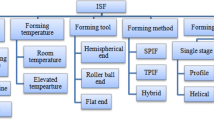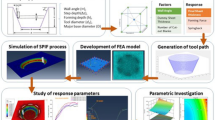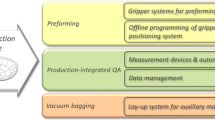Abstract
The autoclave molding method is performed by stacking CFRP prepreg sheets in a mold; this method is widely used in airplanes and by the automobile industry. Most three-dimensional-shaped parts are manually produced by the hand lay-up stacking sequence method. Because of this, mechanical properties such as shape accuracy and strength vary depending on the worker’s skill. This is the major issue when tackling the difficulty of quality control in hand lay-up molded products. In order to alleviate these quality management difficulties, ideally, all workers are provided operation manuals and obtain the sufficient skills to prevent individual differences from occurring in the hand lay-up process. In this study, we aim to establish qualification criteria and standardize the work process of this method. We discuss how the differences in the hand lay-up work process influence the mechanical performance of molded products, based on the workers’ skill.
You have full access to this open access chapter, Download conference paper PDF
Similar content being viewed by others
Keywords
1 Introduction
The autoclave molding method is performed by stacking CFRP prepreg sheets in a mold; this method is widely used in airplanes and by the automobile industry. Most three-dimensional-shaped parts are manually produced by the hand lay-up stacking sequence method. Because of this, mechanical properties such as shape accuracy and strength vary depending on the worker’s skill. This is the major issue when tackling the difficulty of quality control in hand lay-up molded products. In order to alleviate these quality management difficulties, ideally, all workers are provided operation manuals and obtain the sufficient skills to prevent individual differences from occurring in the hand lay-up process. However, there is no efficient curriculum to support workers in acquiring these skills and no assessment system to establish skill level. Moreover, there is no useful literature to explicitly explain the hand lay-up method and the molding tools used in this process; no reports verifying how working process variations influence the performance of molded products currently exist. In this study, we aim to establish qualification criteria and standardize the work process of this method. We discuss how the differences in the hand lay-up work process influence the mechanical performance of molded products, based on the workers’ skill.
2 Experimental Method
As shown in Fig. 1, we used a tray-shaped square mold measuring 405 mm on each side; the edge height was 30 mm.
2.1 Experimental Materials
We used carbon fiber T-300 3 K plain woven fabric epoxy prepreg sheet (produced by Toho Tenax Co., Ltd.) as the reinforcing material.
2.2 Experimental Method
Carbon cloth prepreg was stacked in three layers in this mold. Based on the square mold’s sides we set the fiber orientation of carbon cloth; the first layer was 0 degrees, the second at 45 degrees, and the third 90 degrees. The following processes required the hand lay-up method to be applied to this mold. The subjects were allowed to decide the process order and choose molding tools for themselves. Subject A had 12 years of professional experience, Subject B had 2 years, and Subject C only had 11 months. In order to analyze this method we recorded the hand lay-up work process performed by each subject with a video camera; their postures and motions while working are shown in Table 1. We compared the process order, molding tools, and time needed for each process, as well as their overall body posture.
2.3 Molding Method
While the motion by the expert, Subject A, was very smooth as shown in Fig. 2, Subject C’s motions were very awkward. When considering working posture, Subject A’s body was tilted forward; he bent his head and was closer to the mold than subject C. We will verify these details in further analysis.
The appearances of the molds processed by Subjects A and C were compared. While there were no wrinkles on Subject C’s mold’s bottom surface, a wrinkle was observed on the mold processed by Subject A. The original carbon fiber alignment also remained in the corner of Subject C’s mold. Moreover, in order to examine the accuracy of the mold shapes performed by each subject, we bisected the molds and measured the thickness at the corners plus the bending radius for comparison.
2.4 Specimens and Evaluation Method
For the tensile test, we cut rectangular specimens 30 mm x 20mm in size from the bottom surface of the mold shown in Fig. 1. For the results shown in Fig. 3 and Table 2, we clarified how the differences in the working processes influenced shape accuracy and mechanical properties of the finished mold; we also illuminated the fundamental working process of the hand lay-up method and displayed the instructions for this process.
3 Experimental Results and Discussion
There are three major elements in the mold designated for this study – it is flat and smooth surface, with corner R, and deep edges in the four corners. It looks typically-shaped, but was designated to require a great deal of skill to use. Thus, significant difference appeared in expert and non-expert’s mold’s mechanical properties. In order to verify the details, we will repeat this study on a constant basis with more subjects. The amount of time required for stacking as well as bagging are clearly shown in Fig. 4. The amount of time required to apply several layers was almost the same; however, in the bagging process, with the difference of making wrinkles as small as possible in the bagging film and release film, and preventing wrinkles from occurring, it was clear through analysis and just by looking that the parts that were rich in resin had been successfully made as small as possible.
In Fig. 5, it is apparent that subject C often spent most of his time using the tools repeating the same actions, while Subject A clearly distinguished the roles of the scissors and Stanley knife used on one side of the cut to use the tools in as minimal a process as possible. Thus, he adopted two of the three different ways to use a chisel, separated the fiber from the chisel holding down angle R and his fingertips, and had become familiar with the pattern of repeating the process for the third layer, eliminating wasted time. It is clear that by increasing and decreasing the strength applied to the fingertip on the bamboo chisel in the bagging process, the auxiliary raw materials that gather on the inside of the wrinkles in the bagging film are made smaller.
We analyzed the 19 different processes involved in molding the three layers, as is shown in the process analysis graph in Fig. 6. By expressing the entire process from preparations before stacking until completing the stacking, the axis for the amount of time that Subject C required to repeat each action is made even clearer. In particular, the actions that were repeated in the process of molding angle R are heavily represented, and for subject A, apart from time spent on angle R and corner R on the first side, it is a speedy allocation of time.
The process analysis has also been arranged into the chart in Table 3 to further clarify from a finer point of view. Because Subject A was clear on the purpose of the process, he was able to quickly setup his next actions and execute the task while using both hands evenly and looking at all of the corners. However, because of repeated movements that cause wrinkles due to the gathering of wrinkles and uneven application of strength in his actions, Subject C’s inability to make decisions and lack of awareness of the purpose affected his actions. Furthermore, working postures of the two subjects were clearly different. Subject A had stable body movements, while Subject C’s neck had bent his neck towards the desk and at a right angle, and his body was askew when working.
The cross-section analysis shown in Fig. 7 is the cross-section that was closest to a right angle. The other three sides clearly showed cross-sections of corners that are not shown in the estimated results or actual results. However, in contrast to Subject A’s smooth cross-section between lawyers, for Subject C, the cross-section of the fiber and uneven resin, and the thickness of the unevenness and the cross-section are also uneven. Furthermore, Subject C’s other angle Rs were confirmed to have gaps and wrinkles. Thus, the technical ability to an angle R that is close to a right angle is required.
It is clear from the test specimen results on the underside of the mold that the effects on the mechanical properties are similar, as is shown in Fig. 8. Because the need for tracking from the underside is low, we have plotted angle R’s need for tracking.
4 Conclusion
By specifying the requirements and purpose in the initial molding conditions, we could clarify the differences between experts and non-expert workers in the selection of molding tools, working postures, time needed, and the overall working process. This helped us understand the need to standardize the hand lay-up method using CFRP prepreg sheets, which has been recently gaining popularity; these are the origins related to the basic elements of mass-production robot work. Because of this, we will continuously explore the fundamental concepts inherent in the plane, corner R, and edge, and the need to continuously train and encourage workers to obtain a high level of expertise. It is clear from the actions of our subjects that they are able to act quickly by planning what to do next based on their level of experience and that the amount of strength applied to the fingertips and tools creates an effect. Despite the conditions they were given being the same, the ability to transition between setting-up different processes and maintain concentration are closely linked to your body’s muscle memory. The next challenge is to clarify this with three-point bending tests and durability tests, and determine whether any differences occur when increasing the number of layers.
References
Ogasawara, T., Yoshikawa, N.: JSME Annual Meeting 8, 37–38 (2010)
Matsumoto, T., Minemura, T., Masago, J., Hayashikawa, T., He, X.: Theory application dynamics lecture memoirs 58, 42–42
Nishikawa, Y., et al.: Materials 54, 494–499
Hirano, Y., Kusano, H., Aoki, Y.: Compos. Sci. Technol 40, 153–159 (2014)
Suzuki, N., Koyanagi, J., Arikawa, S.: Compos. Sci. Technol. 40, 160–169 (2014)
Yoneyama, S., Koyanagi, J., Arikawa, S.: Compos. Sci. Technol. 40, 35–43 (2014)
Author information
Authors and Affiliations
Corresponding author
Editor information
Editors and Affiliations
Rights and permissions
Copyright information
© 2015 Springer International Publishing Switzerland
About this paper
Cite this paper
Uchida, T. et al. (2015). Process Analysis of the Hand Lay-Up Method Using CFRP Prepreg Sheets. In: Duffy, V. (eds) Digital Human Modeling. Applications in Health, Safety, Ergonomics and Risk Management: Ergonomics and Health. DHM 2015. Lecture Notes in Computer Science(), vol 9185. Springer, Cham. https://doi.org/10.1007/978-3-319-21070-4_23
Download citation
DOI: https://doi.org/10.1007/978-3-319-21070-4_23
Published:
Publisher Name: Springer, Cham
Print ISBN: 978-3-319-21069-8
Online ISBN: 978-3-319-21070-4
eBook Packages: Computer ScienceComputer Science (R0)












